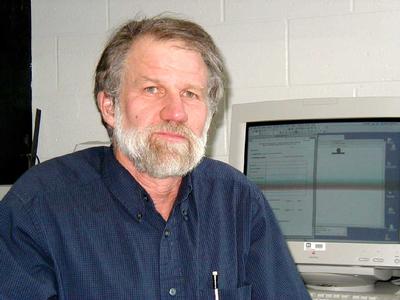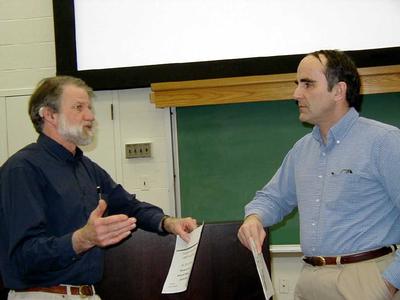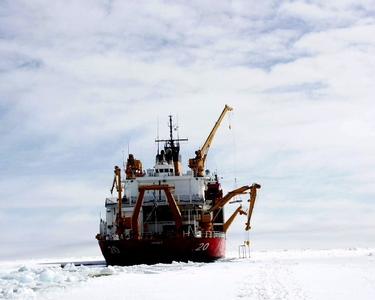7 April, 2001
Walter (Terry) B. Tucker III, Research Geophysicist
Specializing in sea ice studies for 30 years, Walter B. Tucker III, ("Terry"
to his colleagues and friends), of the Cold Regions Research and Engineering
Laboratory (CRREL), Hanover, New Hampshire, began his career using laser
profiles from aircraft to study the surface roughness of sea ice. It is
this expertise that lead Terry to his later investigations assessing the
thickness of ridging ice in individual pressure ridges and consequently to
his more recent research focusing on the characterization of sea ice.
In 1984, Terry Tucker had the opportunity to go to Fram Strait where he
collected ice cores for measurements in temperature, salinity and crystal
structure. Until this time, few people had conducted crystal studies of
Arctic sea ice. Because 80 to 90 percent of Arctic sea ice passes through
Fram Strait, this data is representative of much of the sea ice in the
Arctic Ocean.
Throughout his career, Terry Tucker has traveled extensively in the Arctic
Regions spending time at field camps researching ice properties and
collecting ice thickness data. For several years, Terry collected
measurements of the in-situ stress of the ice covers in addition to other
measurements of ice properties. Keeping ice core property and thickness
measurements as his focus, Mr. Tucker was successful in his attempts to
access submarine collected ice profile data. He processed and analyzed this
data in his interest in global climate change affecting the thinning and
shrinking of the Arctic ice pack.
Several major field programs highlight Terry Tucker's career in sea ice
research. The most recent is his ice characterization studies for the Sea
Ice Trials 2000 of the new icebreaker, United States Coast Guard Cutter
Healy, in the Canadian Arctic (http://www.uscg.mil/pacarea/healy). In order
to define the operational characteristics of this new icebreaker, the
strength and thickness of the ice was essential information. The ice
properties measurements were combined with the USCGC Healy's operational
data at the end of each test for assessing the performance of the
icebreaker.
Another highlight is Terry's parcticipation in Project Surface Heat Budget of
the Arctic Ocean (SHEBA, http://sheba.apl.washington.edu). In this
experiment, a Canadian Coast Guard icebreaker, Des Groseilliers, became
frozen in the Beaufort Sea and allowed to drift with the ice floes for one
year. Des Groseilliers served as an operations base for camps and
scientific snow and ice studies being conducted on the surrounding ice
sheets from October 1997 to October 1998. An arcticle written for science
teachers and students over-viewing Project SHEBA, "Year on Ice Gives
Climate Insights," by D.K. Perovich et al can be found in the December 1999
edition of Earth in Space, a magazine published by the American Geophysical
Union.
Terry Tucker names The 1994 Arctic Ocean Section trial (AOS-94,
http://www.crrel.usace.army.mil/techpub/CRREL_Reports/reports/AOS_SR96_23.pd
f), the first major scientific crossing of the Arctic Ocean, as an added
highlight of his career in ice research. This expedition partnered the
United States and Canada in an endeavor to increase understanding of the
role of the Arctic in global change and to collect baseline data on regional
contaminants. This multidisciplinary experiment comprising fifty individual
research programs was the first expedition of its type in North America.
Several Coast Guard expeditions to the Beaufort Sea, Chukchi Sea and the
Marginal Ice Zone in the Greenland Sea for ice coring and conducting ice
property research combine as further highlights to Terry Tucker's career.
For additional information, photos and Mr. Tucker's contact information at
CRREL go to http://www.crrel.usace.army.mil/sid/personnel/tucker.html.
Investigate the Cold Regions Research and Engineering Laboratory (CRREL)
virtual library at
http://www.crrel.usace.army.mil/library/crrel_library.html for additional
information and resources. THE 1994 ARCTIC OCEAN SECTION: THE FIRST MAJOR
SCIENTIFIC CROSSING OF THE ARCTIC OCEAN (1996) edited by Walter Tucker and
David Cate is published by U.S. Army Cold Regions Research and Engineering
Laboratory, 72 Lyme Road, Hanover, NH 03755. It is identified as Special
Report 96-23.
By Sandra Kolb, March 2001

Walter (Terry) B. Tucker III in his office at CRREL. Photo by Sandra Kolb.

Terry Tucker (left) and Don Perovich (right) discussing the shrinking and thinning of the Arctic ice pack following a seminar presented by Terry Tucker and John Weatherly at CRREL. Photo by Sandra Kolb.

Walter (Terry) B. Tucker III in the USCGC Healy bridge during this icebreakerís Sea Ice Trials 2000 in the Canadian Arctic. Photo by Sandra Kolb.

The Sea Ice Trials 2000 of the new icebreaker, United States Coast Guard Cutter Healy, in the Canadian Arctic. Photo by Sandra Kolb.

Patch showing the partnering of the science community and the U.S. Coast Guard. Photo by Sandra Kolb.
Contact the TEA in the field at
.
If you cannot connect through your browser, copy the
TEA's e-mail address in the "To:" line of
your favorite e-mail package.
|
